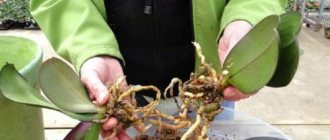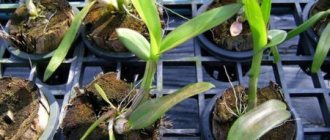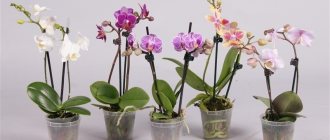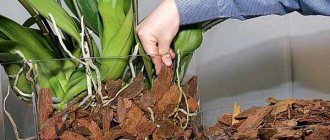Reproduction of orchids in nature
Before talking about methods for propagating orchids at home, it is important to understand what a plant needs for propagation. In nature, there are over 20 thousand species of orchids and each of them has its own characteristics and conditions in which procreation occurs.
When talking about orchids, we usually mean the plants that are most adapted to home conditions:
- phalaenopsis;
- dendrobiums;
- Cumbria;
- cymbidiums;
- oncidium;
- vandas;
- miltonia;
- Cattleyas.
How do orchids of these species reproduce in nature? Some of them belong to sympodial species, which have many growth points and easily reproduce by division, and some are monopodial species, which reproduce mainly with the help of children. A common factor in procreation in all flowering plants, including orchids, is propagation by seeds. Once in the soil, the seeds are completely dependent on the beneficial fungal flora, which provides them with a nutrient medium and the opportunity to germinate.
In a similar way, procreation occurs in domestic plants. Sympodial species - dendrobiums, cambrians, cymbidiums, cattleyas, oncidiums, easily reproduce by division. Every year they produce new and new growths, as a result of which the owner has to plant them one way or another. In monopodial orchids, this process is more complex and in order for the orchid to give birth to a baby, it is necessary to create optimal conditions.
Read on to find out how to do this.
The appearance of mold on the orchid substrate
This is one of the most common problems. Mold appears due to stagnant air. It is important to ensure circulation or periodic ventilation of the greenhouse. This minimizes the risk of mold. Otherwise, the lesions must be removed without fail.
Conditions necessary for reproduction
Growing orchids requires a number of skills and can be challenging for beginners unfamiliar with plant cycles. It is recommended to provoke the appearance of children with various stimulants only in healthy flowers, since a plant with weak or diseased roots may not withstand the load and die.
The time of year is also of great importance, since lighting, temperature and humidity create good conditions for both flowering and the formation of new shoots. Most often, orchids at home begin to reproduce in the spring: after a short daylight hours in the winter season, the increase in light gives a signal to the plant that a favorable period is approaching. If the remaining conditions are suitable for the plant - temperature and watering regime, then the plant will begin to produce new shoots.
Next, we’ll talk about what methods of propagating orchids are acceptable for home use, and how the owner of these beautiful flowers can influence the continuation of their species.
What to do during this process?
- Place the container with the flower in a well-lit place. Windows facing south, southeast and southwest are suitable for this.
- If daylight hours last less than 12 hours, then the orchid must be placed under an additional light source (fluorescent lamp, phytolamp).
- Provide systematic moderate watering with settled or boiled water at room temperature.
- Continue to feed the plant if this was done before the arrow was released.
As a top dressing, ready-made mineral fertilizers for orchids containing phosphorus and potassium are usually used. They are sold in specialized stores. If fertilizing has not been done before, then you should not start with the release of the arrow - the orchid may “freeze”.
We invite you to watch a video containing recommendations for caring for orchids that have released a peduncle:
Propagation of orchids by division at home
As already mentioned, the division method is in most cases suitable for sympodial species. Since all pseudobulbs are united by a rhizome, or, as it is also called, a rhizome, new growth is just a matter of time. But it is equally important to know that you need to divide plants only in cases where there are too many pseudobulbs and the entire root system no longer fits in the pot.
In addition to dividing, there is another option: transplant the overgrown plant into a larger pot. As practice shows, sympodial orchids with a large number bloom more luxuriantly and have better immunity to diseases and pests. Therefore, here you need to be guided by the principle “Measure seven times.”
If you decide to divide your orchid, the question will probably arise as to how to divide it without harming the flower. To do this, it is important to determine where the rhizome is located and divide according to it. It is extremely important that each division has at least 3 pseudobulbs; the more there are, the faster the orchid adapts after division.
Another important feature of sympodial orchids is that the faded pseudobulb will no longer bloom, therefore, when dividing the plant, you need to leave the old ones with the new growths; they will initially nourish and support the young plant, and then dry out over time.
The separation action plan should be as follows:
- We take the plant out of the pot and use a sterile instrument to separate the pseudobulbs.
- The rhizome cut should be processed. A garden pitch is suitable for this, or you can simply drip it with wax or paraffin.
For many adherents of phalaenopsis who have not encountered other species before, the question of how to plant a dendrobium orchid becomes very relevant. It is worth noting that, although dendrobium is a sympodial species, division is not the only type of its reproduction. Sometimes babies begin to grow on pseudobulbs, which eventually grow roots.
Once the baby has produced new growth, followed by a new pseudobulb, and grown sufficient roots to support its own life, it can be removed by careful cutting with a sterile, sharp instrument.
Important tip! Do not remove from the dendrobium children with one growth or pseudobulb, as well as new shoots without aerial roots. It is impossible to propagate an orchid of this type without roots, since they provide the basis for growth, and not vice versa.
What to do if you can't escape?
- Arrange a temperature difference . The difference between the thermometer readings at night and during the day should be 5C – 7C. A similar difference can be achieved by placing the orchid pot on a heated balcony or terrace.
- Provide enough light for the plant. The required daylight hours are 10–12 hours. In the cold season (autumn, winter), the flower must be illuminated with a phytolamp.
- Ensure proper watering . The orchid requires moderate, systematic watering before flowering and when the arrow appears. But it is important to remember the main principle: do not flood the roots! It is necessary to constantly monitor the condition of the root system and substrate.
Monitor the humidity level in the room where the orchid is located. To release the arrow, the optimal humidity should be 30% - 40%.- Provide the plant with fertilizers based on potassium and phosphorus: they have a beneficial effect on the formation of flower buds.
- Scare . If the above points have been completed, but the orchid has not released an arrow, then it is recommended to arrange a stressful situation for it: reduce watering to a minimum and move the pot to a cooler place.
Some florists use special chemicals to stimulate orchids to bloom. "Epin" is very popular. They should spray the plant daily in the morning.
You can also water the plant by adding 3 to 5 drops of the drug to the water (details in the instructions).
Cytokinin paste is used as a phytoharmone, and succinic acid is used as a growth regulator and anti-stress drug (dissolve 2 g in 1 liter of water).
We suggest watching a video about why an orchid does not produce a peduncle and what to do in this case:
Reproduction of orchids by root children
Propagation of orchids by root children at home is practiced quite often, but it is important to understand in what cases this should be done. Monopodial species of orchids reproduce by basal children, such as:
- phalaenopsis;
- Wanda;
- vanilla;
- brassavola.
One of the most frequently asked questions among novice gardeners is how to grow an orchid from roots. To answer it, you need to define the concepts.
It is almost impossible to grow an orchid from a root naturally: this happens either in the event of the death of the mother plant or in the case of rejuvenation of the old orchid. Moreover, a prerequisite is that the roots must be strong enough and located on the remainder of the trunk, which orchid growers often call the “stem.”
In other cases, having cut off a piece of root, it is completely pointless to wait for a new growth point to appear from it.
So, how to plant an orchid to get basal children? To do this, flower growers use horizontal division of the bush. However, it should be noted that this method is quite extreme and requires the following conditions:
- the plant must have a healthy root mass;
- The orchid trunk must have at least three aerial roots, 5-8 cm long.
The action plan will be as follows:
- We take the plant out of the pot and carefully examine the roots again.
- We mark the place of pruning: usually, when dividing with the roots, the two lower leaves are left, and the upper part, together with the aerial roots, is separated with a sterile instrument.
- We treat the sections with antiseptics: phytosporin or crushed activated carbon.
- We plant the roots together with the remaining leaves in an old pot with an old substrate and reduce watering by 2 times.
- We plant the top in a new pot according to the size of the aerial roots, using a new substrate.
- Water the tops after 4 days, apply fertilizers no earlier than 30 days.
- To support a divided plant, you can use succinic acid by wiping the leaves or spraying with a fine dispersion spray bottle.
Further, caring for the divisions is no different from ordinary plant care. After a while, green shoots may appear on the “stalk” - this is the root baby. After its appearance, fertilizers should be applied 2 times a month using the root method.
In addition to propagating orchids by roots, there are a number of other ways to make several from one plant. How to do this - read on.
Role in the life of a plant
The arrow of an orchid performs a reproductive function. It most often produces babies - small copies of the orchid itself. After they produce a couple of leaves and 3-4 roots, they can be rooted.
In addition, the peduncle is involved in the appearance and development of flowers and buds , nourishes them with water and nutrients, thereby continuing to perform a reproductive function. Each orchid flower contains a seed capsule in which the seeds ripen after pollination by insects. An orchid can also be grown from seeds, but this can happen either in a natural environment - the tropics, or in laboratories, since this process is long and intricate.
Propagation of orchids by cuttings
In order to propagate an orchid by cuttings, you need to know for which species this method is suitable. Oddly enough, both sympodial and monopodial species can be propagated by cuttings. In the first case, cuttings will be carried out with a pseudobulb, and in the second - with peduncles.
The best results of this type of propagation are produced by dendrobiums and phalaenopsis. However, there are also negative experiences, since the result depends on many factors: environment, lighting, and most importantly, the genetic characteristics of the orchid. Experienced gardeners also do not recommend using cymbidiums, cattleyas and other more expensive species for this.
So what should you do to propagate from cuttings?
- We will need a peduncle or pseudobulb. The peduncle can be cut off after it begins to dry out, and the pseudobulb can be taken from any faded dendrobium.
- We will need a mixture of fine bark and sphagnum moss.
- Sections of peduncles can be dried, sections of pseudobulbs can be treated with phytosporin or filled with paraffin.
- We place the prepared substrate in a greenhouse and place the cuttings there.
- As the substrate dries, it should be moistened with a spray bottle. The temperature should be maintained at 23-25 degrees, there should also be diffused light and regular ventilation.
The first results can be seen within 1-2 weeks. Dormant buds may awaken on the peduncles of phalaenopsis, and new shoots may appear on the pseudobulbs of dendrobium, which will eventually become babies.
What it looks like in the photo
A baby should be understood as a fully developed orchid bush with its own rosette of small leaves and a root system.
This is an exact copy of an adult plant. Sometimes it is called “cake”. Where exactly the cake grows from, and whether it will be a baby and not a peduncle, depends on the genetic characteristics of a particular orchid.
On the peduncle
On the roots
Reproduction of orchids by children
This method is most relevant for the most common orchids of the phalaenopsis species. It is these plants that reproduce very readily even without additional intervention from the grower. Reproduction of orchids at home with the help of children can be provoked by hormonal pastes containing cytokinins. However, children often appear in the roots and on the trunk of the plant itself.
Important! Paste for propagating orchids is sold freely in the CIS, but in European countries it is quite difficult to purchase. It has side effects and its own characteristics of use.
This paste contains phytohormones - cytokinins, which accelerate the plant's metabolism and enhance the growth of new shoots and buds. However, it should only be used on healthy and mature plants.
The natural appearance of babies in orchids is possible immediately after flowering. The upper or middle bud on the peduncle awakens and produces either new growth or a new shoot. Read on to learn how to propagate orchids using paste.
Baby on a peduncle
In order to get a baby on a peduncle, you can use cytokinin paste. The action plan will be as follows:
- Using a sterile instrument, it is necessary to bend back the scales covering the dormant bud.
- Use a heated needle or clean toothpick to scratch the plant tissue next to it.
- Apply the paste to the dormant bud in a volume the size of a pinhead.
- The awakening of the kidney can be observed on days 7-10.
Propagation using orchid paste can result in the formation of 2-3 new shoots from one bud. Such mutations are very harmful to the aesthetic appearance and lead to severe stress on the mother plant. This can happen both due to an overdose of hormonal paste, and due to genetic pathologies in development. It is difficult to say how strong or weak the baby will be, but, according to numerous reviews from flower growers, the offspring after cytokinin paste are an order of magnitude weaker, and the flowering is not as lush as that of the mother.
Another important point when propagating orchids by children is the need for proper rooting of the child. Quite often, young growths are in no hurry to build up the root system, but they push out new leaves one after another and may even bloom. This situation has a negative impact on the mother; she may not have enough strength to feed the baby.
A good way to quickly grow roots in young plants is to create a cushion of moss or so-called planting in a pot directly on the mother’s peduncle. For this we need:
- A small pot with a diameter of 2.5 cm or a cut plastic bottle of 0.5 liters.
- Scissors.
- Scotch.
- Sphagnum moss.
- Pin.
At the bottom of the pot we make a hole for the diameter of the peduncle. Using scissors, we cut the pot vertically down to the hole and wrap the pot around the peduncle so that the baby is ¾ of the way up to the pot. Secure the container from below with a clothespin. We glue the walls of the pot together with tape and put sphagnum moss inside, after moistening it with water and a rooting agent. A good drug for this is Kornevin - it is accessible and inexpensive.
This method adapts young plants well to independent life, and the undoubted advantage is that the orchid immediately learns to feed on roots, which reduces stress during transplantation. Among other things, flower growers note a positive point in the fact that the roots immediately grow inside the pot and the transplant will be less traumatic.
Root baby
Basal children, or as they are also called, basal, can appear in monopodial orchid species. Most often they begin to grow in phalaenopsis, but it is impossible to induce an orchid to this type of reproduction. As a rule, a basal baby appears when the mother plant is in danger and the plant does not want to interrupt its life cycle.
Experienced gardeners categorically do not recommend smearing the trunk of healthy phalaenopsis with cytokinin paste - this method can be detrimental to the plant.
Step-by-step instruction
Compared to everything else, sowing itself is a relatively simple procedure. But even here it is necessary to maintain complete sterility. The time for emergence of seedlings, depending on the type of orchid, varies from a week or one and a half to 6–9 months.
The germination process of orchid seeds looks something like this
At all stages of cultivation, the required conditions do not change. Orchids are provided with bright diffused light, placing its source approximately 30 cm above the plantings at a slight angle, daylight hours of at least 14 hours, a temperature of 25–28ºС without sudden changes and humidity of at least 70%.
Seeds are sown over steam to maintain a sterile environment.
- Place a wire rack or mesh over a wide pan of boiling water. Securely fix the vessel with the nutrient mixture on it. The lid from it should be located here, above the steam.
- Using a sterile syringe or a special chemical pipette, remove the seeds in small portions from the solution in which they were sterilized and distribute them over the surface of the substrate without touching it. Everything needs to be done as quickly as possible.
- Gently rock the flasks to distribute the seeds more evenly. Close the containers tightly and place in the chosen location. A home mini-greenhouse, florarium or homemade “greenhouse” is suitable for them.
- First, tiny green “balls” should appear. They then form hair-like rhizoids (to absorb nutrients). Next, leaves appear and, lastly, roots (when the plant has 2-3 true leaves).
- After about a year, remove the seedlings from the jar using tongs in a circular motion, as if twisting, and carefully wash off the nutrient mixture from them. An alternative is to pour some warm water into the container and shake lightly in a circular motion. Pour the mixture with the sprouts into a shallow, wide container, add 2–3 ml of a 0.5% Fundazol solution. Let stand for 10–15 minutes and remove the seedlings with a soft, thin brush.
- Fill plastic cups with drainage material. The height of the container should approximately coincide with the diameter of the roots. It is better if they are transparent - this will make it possible to control the condition of the root system.
- Transplant the orchids into a substrate of crushed sphagnum moss, fern rhizomes and pine roots (1:1:1). The more uniform it turns out, the better. To prevent the development of mold, add activated carbon crushed into powder (10 tablets per liter of the finished mixture). First, all components of the substrate must be poured with boiling water and left for half an hour.
- Do not water the seedlings, but regularly spray them with soft water warmed to room temperature. Do not let the substrate dry out completely.
- After about 4–6 months, replant the stronger orchids into soil for adult plants and care for them as usual.
Orchids from bulbs
Quite often they write on forums about how to grow an orchid from a bulb. Many people don't know what they are. Bulbs or “carrots” are the pseudobulbs of Cycnades orchids grown and sold in Vietnam. Propagation is a process identical to cuttings, but caring for the sprout is slightly different.
The bulb has a round shape, about 15 cm long, and in appearance is very similar to dendrobium pseudobulbs. Growing it is quite simple: the bulb is planted with its roots in dry bark, slightly deepening its body so that the root collar is open. To strengthen, the cycnades sprout can be secured with a wooden stick.
There is no need to water the bulb until new roots form. However, a developing plant will need warmth and good lighting.
Transplantation and further care
Next, we will discuss in detail how to care for the plant and replant it. Replanting begins when roots 5 cm long have already formed on the baby or the planting pot for the young rosette becomes cramped. The substrate can be purchased ready-made at a garden center, or you can make it yourself using the following ingredients:
- pine bark with a fraction diameter of 1 cm - 5 parts;
- sphagnum moss – 1 part;
- charcoal - 1 part;
- Expanded clay is placed on the bottom of a transparent pot.
The young rosette is transplanted into the prepared substrate . To do this, place 3 cm of drainage and 4 cm of soil at the bottom of the container and place an orchid rosette. Then carefully fill the pot with a mixture of bark and moss.
It is advisable to secure the rosette so that it holds tightly in the container, this will speed up its rooting.
Next, you need to carefully observe how the flower feels; care will consist of:
- timely watering;
- the right location;
- required room temperature.
Propagation of orchids by seeds at home
In the wild, epiphytes reproduce in different ways, but the easiest way is sexually. Not only the plants themselves play a great role here, but also insects, thanks to which orchids are pollinated.
After pollination, the plant develops a seed capsule containing from 3 to 5 million seeds and ripens within 6-8 months. At the end of the process, it bursts, and small, dust-like seeds are carried away by air currents. For development, they require a nutrient medium, which is rich in soil and tree bark.
As for the sexual method of reproduction at home, it is quite difficult to withstand all the conditions. A successful result can only be achieved in completely sterile conditions, and also if an ideal environment for development is provided. However, some gardeners have successful experience in such breeding.
In order to grow an orchid from seeds, it is necessary to create a nutrient medium in which the seeds are sown. Out of 3-5 million, very few will be able to germinate, since due to the small size of the seeds they contain very few nutrients. After 6-8 months, the sprouted seeds will acquire a tuberous appearance and will develop for another 2 years.
However, even here the orchid requires certain conditions. In order for a plant to receive nutrients from the environment, it needs to exist in symbiosis with a certain fungal microflora. The plant's immunity must be sufficient to form a symbiosis with microorganisms, otherwise either the plant will destroy it or the fungus itself will turn into a pathogen and destroy the plant.
It is almost impossible to do all the manipulations for propagating an orchid by seeds at home. To grow orchids from seeds, laboratory conditions or professional home selection are required.
Bottom line
Breeding orchids is an exciting process, because their beauty is difficult to overestimate. To summarize, we can conclude the following:
- There are a large number of propagation methods: cuttings, division, babies, seeds.
- For sympodial and monopodial orchids, different propagation methods are used at home.
- Any method requires a lot of time and special care for young plants.
- Propagation by seeds is in most cases available either to professional orchid breeders or only in laboratory conditions.
How do you propagate your orchids?
Formation methods
The baby appears on the peduncle after the flowering stage. It begins its development from dormant buds - small tubercles with a scaly coating on the stem. However, exceptions are possible: sometimes the cake can ripen from the axil of leaves and on the roots.
Children are produced by monopodial orchids (Vandas, Phalaenopsis, Ascocentrum). Some types of sympodial orchids (dendrobiums, paphiopedilums) are also capable of raising children.











